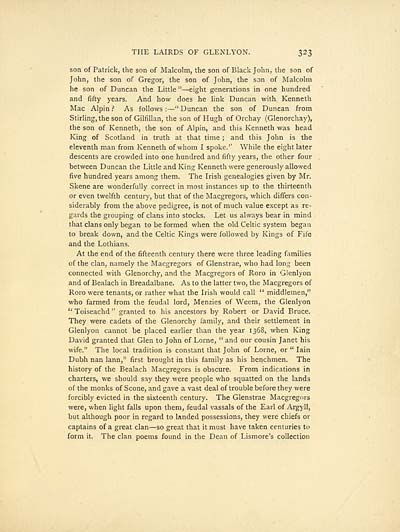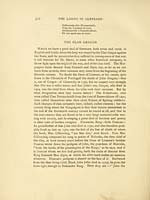Lairds of Glenlyon
(335) Page 323
Download files
Complete book:
Individual page:
Thumbnail gallery: Grid view | List view

THE LAIRDS OF GLENLYON. 323
son of Patrick, the son of Malcolm, the son of Black John, the son of
John, the son of Gregor, the son of John, the son of Malcolm
he son of Duncan the Little" — eight generations in one hundred
and fifty years. And how does he link Duncan with Kenneth
Mac Alpin ? As follows : — " Duncan the son of Duncan from
Stirling, the son of Gilfillan, the son of Hugh of Orchay (Glenorchay),
the son of Kenneth, the son of Alpin, and this Kenneth was head
King of Scotland in truth at that time ; and this John is the
eleventh man from Kenneth of whom I spoke.'' While the eight later
descents are crowded into one hundred and fifty years, the other four
between Duncan the Little and King Kenneth were generously allowed
five hundred years among them. The Irish genealogies given by Mr.
Skene are wonderfully correct in most instances up to the thirteenth
or even twelfth century, but that of the Macgregors, which differs con-
siderably from the above pedigree, is not of much value except as re-
gards the grouping of clans into stocks. Let us always bear in mind
that clans only began to be formed when the old Celtic system began
to break down, and the Celtic Kings were followed by Kings of Fife
and the Lothians.
At the end of the fifteenth century there were three leading families
of the clan, namely the Macgregors of Glenstrae, who had long been
connected with Glenorchy, and the Macgregors of Roro in Glenlyon
and of Bealach in Breadalbane. As to the latter two, the Macgregors of
Roro were tenants, or rather what the Irish would call " middlemen,"
who farmed from the feudal lord, Menzies of Weem, the Glenlyon
"Toiseachd" granted to his ancestors by Robert or David Bruce.
They were cadets of the Glenorchy family, and their settlement in
Glenlyon cannot be placed earlier than the year 1368, when King
David granted that Glen to John of Lome, " and our cousin Janet his
wife." The local tradition is constant that John of Lome, or " Iain
Dubh nan lann," first brought in this family as his henchmen. The
history of the Bealach Macgregors is obscure. From indications in
charters, we should say they were people who squatted on the lands
of the monks of Scone, and gave a vast deal of trouble before they were
forcibly evicted in the sixteenth century. The Glenstrae Macgregors
were, when light falls upon them, feudal vassals of the Earl of Argyll,
but although poor in regard to landed possessions, they were chiefs or
captains of a great clan — so great that it must have taken centuries to
form it. The clan poems found in the Dean of Lismore's collection
son of Patrick, the son of Malcolm, the son of Black John, the son of
John, the son of Gregor, the son of John, the son of Malcolm
he son of Duncan the Little" — eight generations in one hundred
and fifty years. And how does he link Duncan with Kenneth
Mac Alpin ? As follows : — " Duncan the son of Duncan from
Stirling, the son of Gilfillan, the son of Hugh of Orchay (Glenorchay),
the son of Kenneth, the son of Alpin, and this Kenneth was head
King of Scotland in truth at that time ; and this John is the
eleventh man from Kenneth of whom I spoke.'' While the eight later
descents are crowded into one hundred and fifty years, the other four
between Duncan the Little and King Kenneth were generously allowed
five hundred years among them. The Irish genealogies given by Mr.
Skene are wonderfully correct in most instances up to the thirteenth
or even twelfth century, but that of the Macgregors, which differs con-
siderably from the above pedigree, is not of much value except as re-
gards the grouping of clans into stocks. Let us always bear in mind
that clans only began to be formed when the old Celtic system began
to break down, and the Celtic Kings were followed by Kings of Fife
and the Lothians.
At the end of the fifteenth century there were three leading families
of the clan, namely the Macgregors of Glenstrae, who had long been
connected with Glenorchy, and the Macgregors of Roro in Glenlyon
and of Bealach in Breadalbane. As to the latter two, the Macgregors of
Roro were tenants, or rather what the Irish would call " middlemen,"
who farmed from the feudal lord, Menzies of Weem, the Glenlyon
"Toiseachd" granted to his ancestors by Robert or David Bruce.
They were cadets of the Glenorchy family, and their settlement in
Glenlyon cannot be placed earlier than the year 1368, when King
David granted that Glen to John of Lome, " and our cousin Janet his
wife." The local tradition is constant that John of Lome, or " Iain
Dubh nan lann," first brought in this family as his henchmen. The
history of the Bealach Macgregors is obscure. From indications in
charters, we should say they were people who squatted on the lands
of the monks of Scone, and gave a vast deal of trouble before they were
forcibly evicted in the sixteenth century. The Glenstrae Macgregors
were, when light falls upon them, feudal vassals of the Earl of Argyll,
but although poor in regard to landed possessions, they were chiefs or
captains of a great clan — so great that it must have taken centuries to
form it. The clan poems found in the Dean of Lismore's collection
Set display mode to:
![]() Universal Viewer |
Universal Viewer | ![]() Mirador |
Large image | Transcription
Mirador |
Large image | Transcription
Images and transcriptions on this page, including medium image downloads, may be used under the Creative Commons Attribution 4.0 International Licence unless otherwise stated. ![]()
| Histories of Scottish families > Lairds of Glenlyon > (335) Page 323 |
|---|
| Permanent URL | https://digital.nls.uk/95358919 |
|---|
| Description | A selection of almost 400 printed items relating to the history of Scottish families, mostly dating from the 19th and early 20th centuries. Includes memoirs, genealogies and clan histories, with a few produced by emigrant families. The earliest family history goes back to AD 916. |
|---|

